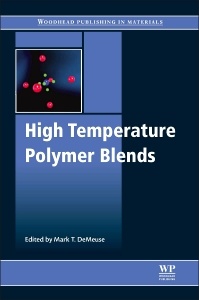Description
High Temperature Polymer Blends
Woodhead Publishing in Materials Series
Coordinator: DeMeuse Mark T.
Language: English
Subjects for High Temperature Polymer Blends:
232 p. · 15.5x23.2 cm · Hardback
Description
/li>Contents
/li>Biography
/li>Comment
/li>
Polymer blends offer properties not easily obtained through the use of a single polymer, including the ability to withstand high temperatures. High Temperature Polymer Blends outlines the characteristics, developments, and use of high temperature polymer blends.
The first chapter introduces high temperature polymer blends, their general principles, and thermodynamics. Further chapters go on to deal with the characterization of high temperature polymer blends for specific uses, such as fuel cells and aerospace applications. The book discusses different types of high temperature polymer blends, including liquid crystal polymers, polysulfones, and polybenzimidazole polymer blends and their commercial applications.
High Temperature Polymer Blends provides a key reference for material scientists, polymer scientists, chemists, and plastic engineers, as well as academics in these fields.
- Dedication
- Contributor contact details
- Chapter 1: Introduction to high temperature polymer blends
- Abstract:
- 1.1 Introduction
- 1.2 General principles of polymer blending
- 1.3 Thermodynamics of polymer blends
- 1.4 Immiscible blends
- 1.5 Conclusions
- Chapter 2: Characterization methods for high temperature polymer blends
- Abstract:
- 2.1 Introduction
- 2.2 High temperature polymer blends (HTPBs)
- 2.3 Methods of polymer characterization
- 2.4 Characterization of polymer blends
- 2.5 Characterization of HTPBs: chemical constitutions and molecular weights
- 2.6 Characterization of HTPBs: chemical-, thermal-, mechanical- and radiation-induced degradation
- 2.7 Stabilization of HTPBs
- 2.8 Challenges in blending polymers
- 2.9 Summary
- 2.10 Future trends
- 2.12 Appendix: Nomenclature
- Chapter 3: Characterization of high temperature polymer blends for specific applications: fuel cells and aerospace applications
- Abstract:
- 3.1 Introduction
- 3.2 High temperature polymer blends (HTPBs) for membrane applications
- 3.3 Fuel cell (FC) membrane applications
- 3.4 Characterization of HTPBs for FC applications
- 3.5 Solar cell (SC) applications
- 3.6 Characterization of HTPBs for polymeric solar cells (PSCs)
- 3.7 Aerospace applications
- 3.8 Characterization of HTPBs for aerospace applications
- 3.9 Summary
- 3.11 Appendix: Nomenclature
- Chapter 4: Thermodynamics of high temperature polymer blends
- Abstract:
- 4.1 Introduction
- 4.2 Blending miscible high temperature polymers
- 4.3 Poly (2,2' (m-phenylene)-5-5' bibenzimidazole) (PBI) blends
- 4.4 Polyimide blends
- 4.5 Liquid crystal polymer blends
- 4.6 Molecular composites
- 4.7 Conclusions
- 4.8 Sources of further information and advice
- Chapter 5: Liquid crystal polymers (LCPs) as a reinforcement in high temperature polymer blends
- Abstract:
- 5.1 Introduction
- 5.2 Researching liquid crystal polymers (LCPs)
- 5.3 Liquid crystals
- 5.4 Polymer liquid crystals
- 5.5 Blends of isotropic and anisotropic thermotropic polymers
- 5.6 Processability of LCP/thermoplastic blends
- 5.7 Structure–property relationships of LCP blended materials
- 5.8 Commercial LCP blends
- 5.9 Conclusions and future trends
- Chapter 6: Polysulfones as a reinforcement in high temperature polymer blends
- Abstract:
- 6.1 Introduction
- 6.2 Structure and properties of polysulfone
- 6.3 Issues in blending polysulfone with other high temperature polymers
- 6.4 Physical properties of polysulfone blends
- 6.5 Polysulfone/thermoset mixtures
- 6.6 Conclusions
- 6.7 Sources of further information and advice
- Chapter 7: Polybenzimidazole (PBI) high temperature polymers and blends
- Abstract:
- 7.1 Introduction
- 7.2 Processing of polybenzimidazole (PBI)
- 7.3 PBI blends
- 7.4 PBI–polyetherketoneketone (PEKK) blends
- 7.5 PBI–polyetherimide (PEI) blends
- 7.6 PBI–polyaryletherketone (PAEK)–PEI blends
- 7.7 PBI–polyarylate (PA) blends
- 7.8 PBI–polysulfone (PS) blends
- 7.9 PBI–polyimide (PI) and PBI–polyamide-imide (PAI) blends
- 7.10 PBI–poly (bisphenol-A carbonate) (PC) and PBI–polybenzoxazole (PBO) blends
- 7.11 PBI–poly(4-vinyl pyridine) (PVPy) and other blends
- 7.11.1 PBI–poly(4-vinyl pyridine) (PVPy) blends
- 7.11.2 Other blends
- 7.12 PBI commercial products
- 7.13 PBI in high temperature applications
- 7.14 Future trends
- 7.15 Sources of further information and advice
- Index
- Reviews characterization methods and analysis of the thermodynamic properties of high temperature polymer blends
- Reviews the use of materials such as liquid crystals as reinforcements as well as applications in such areas as energy and aerospace engineering




